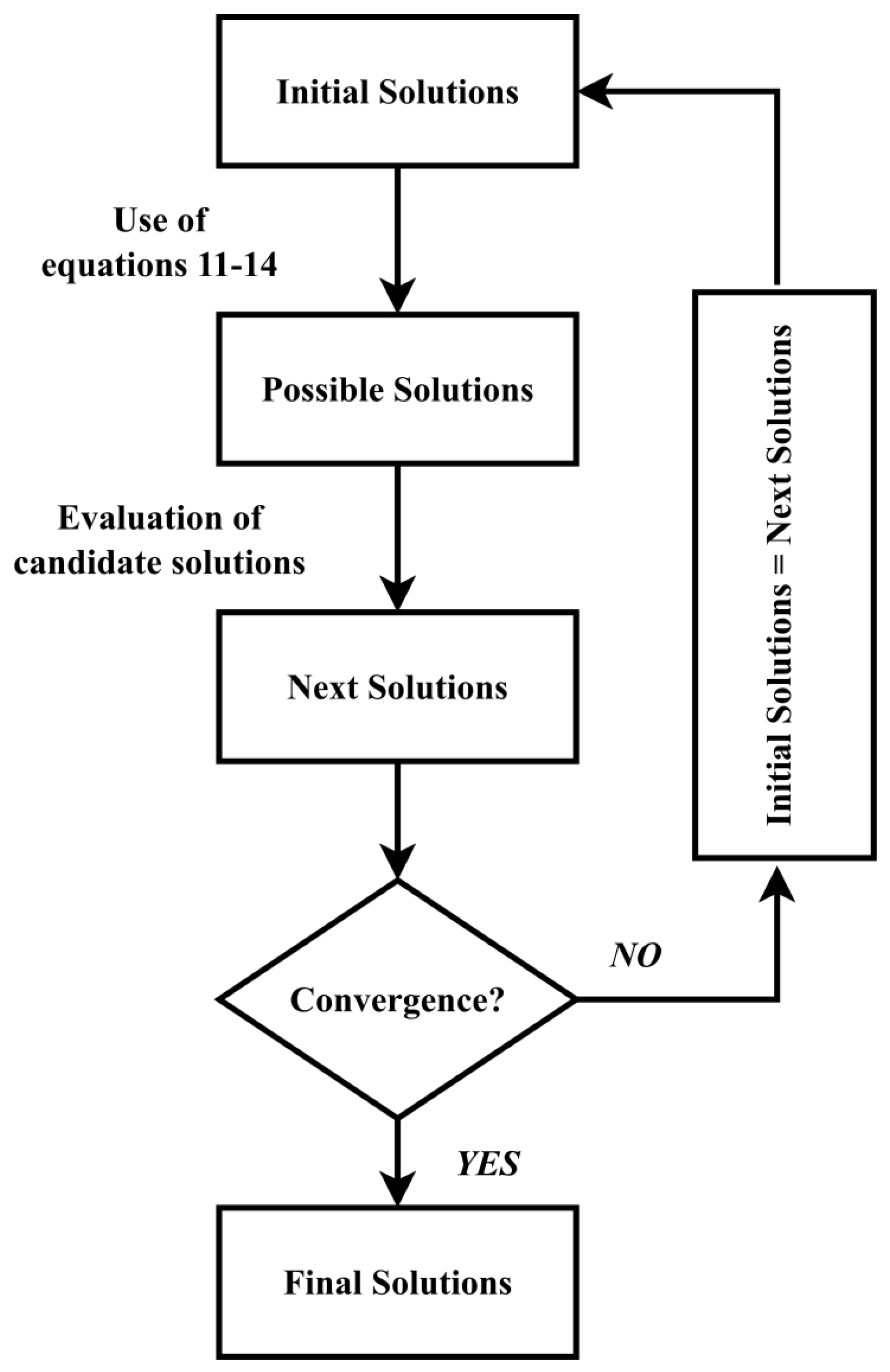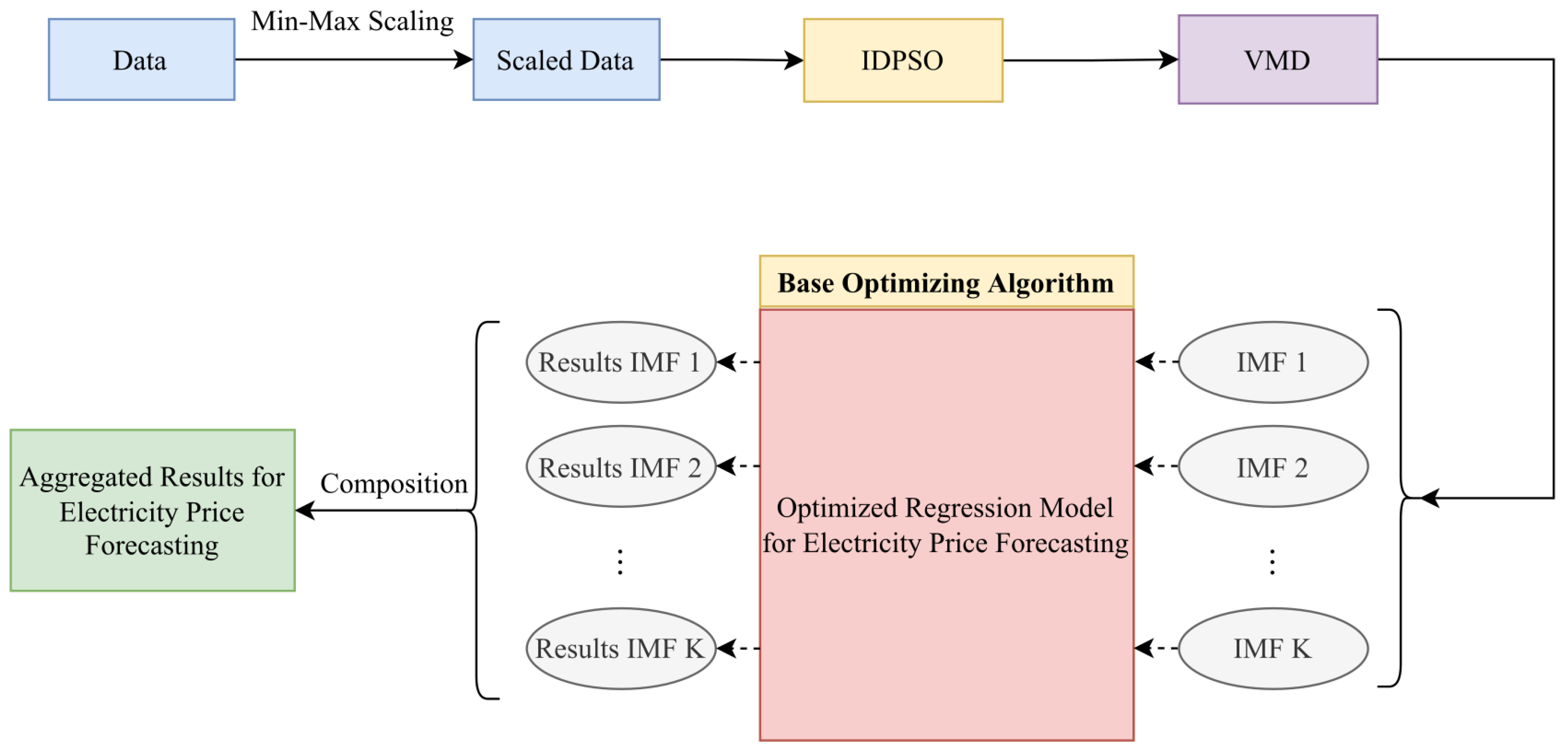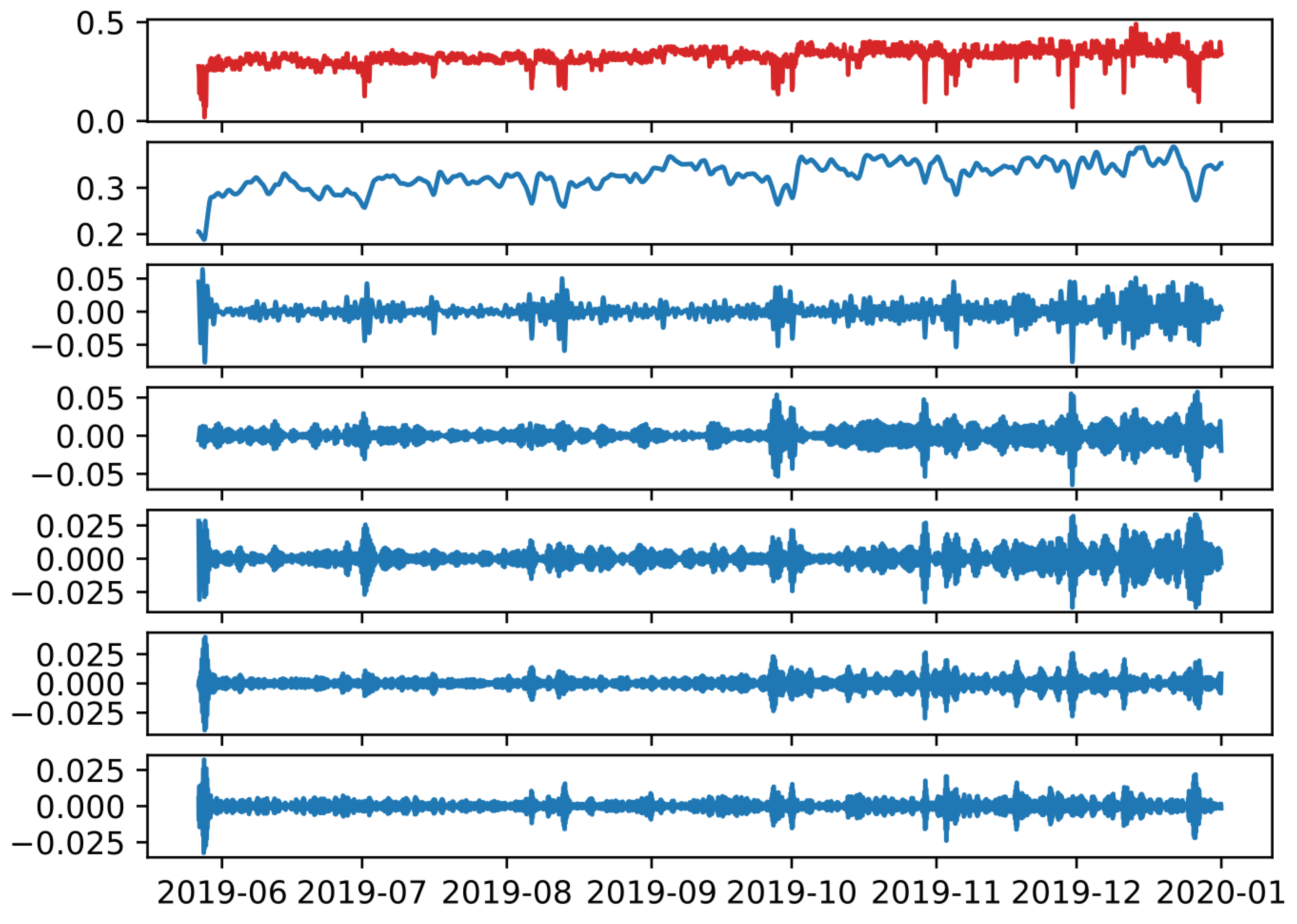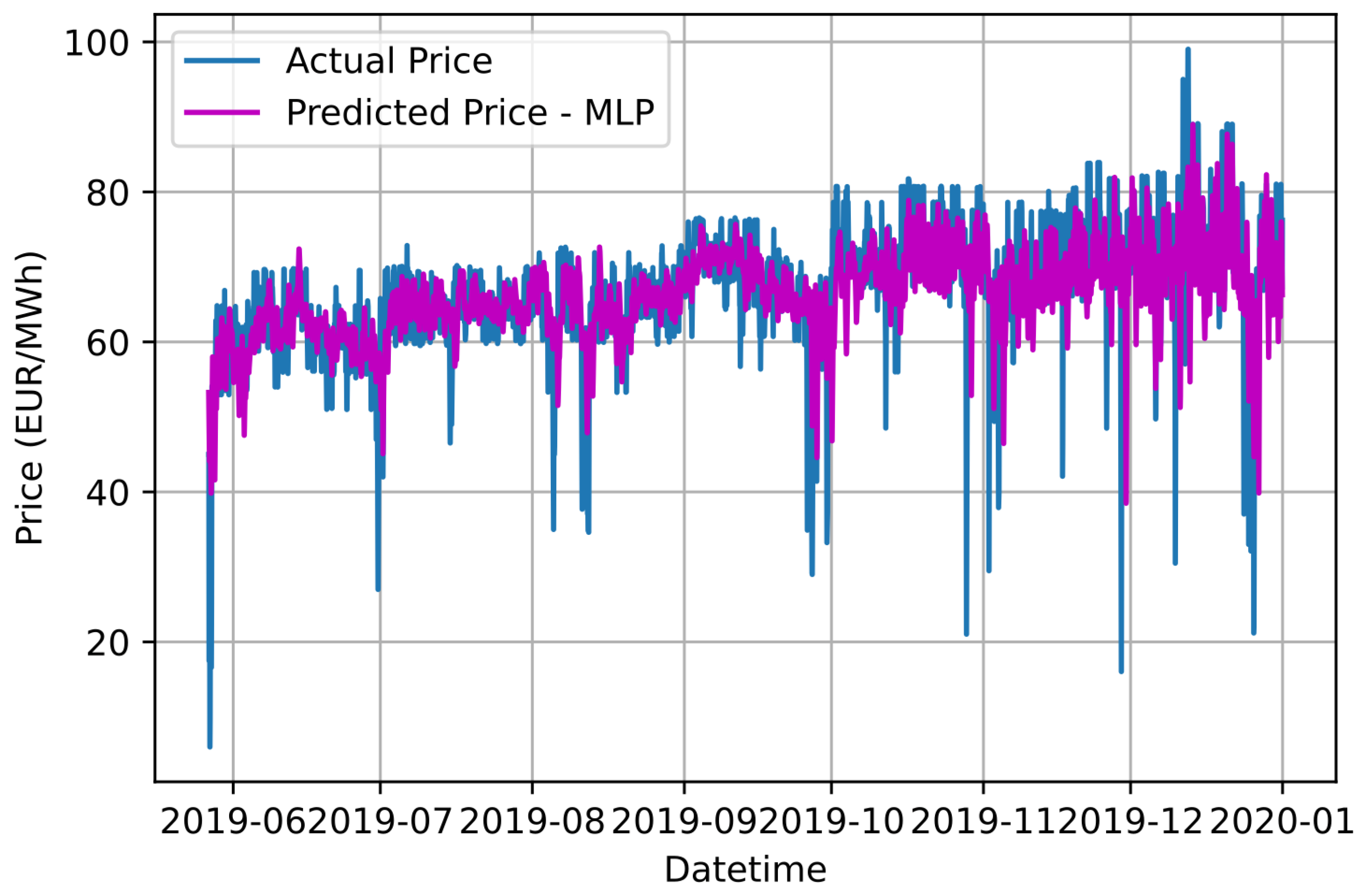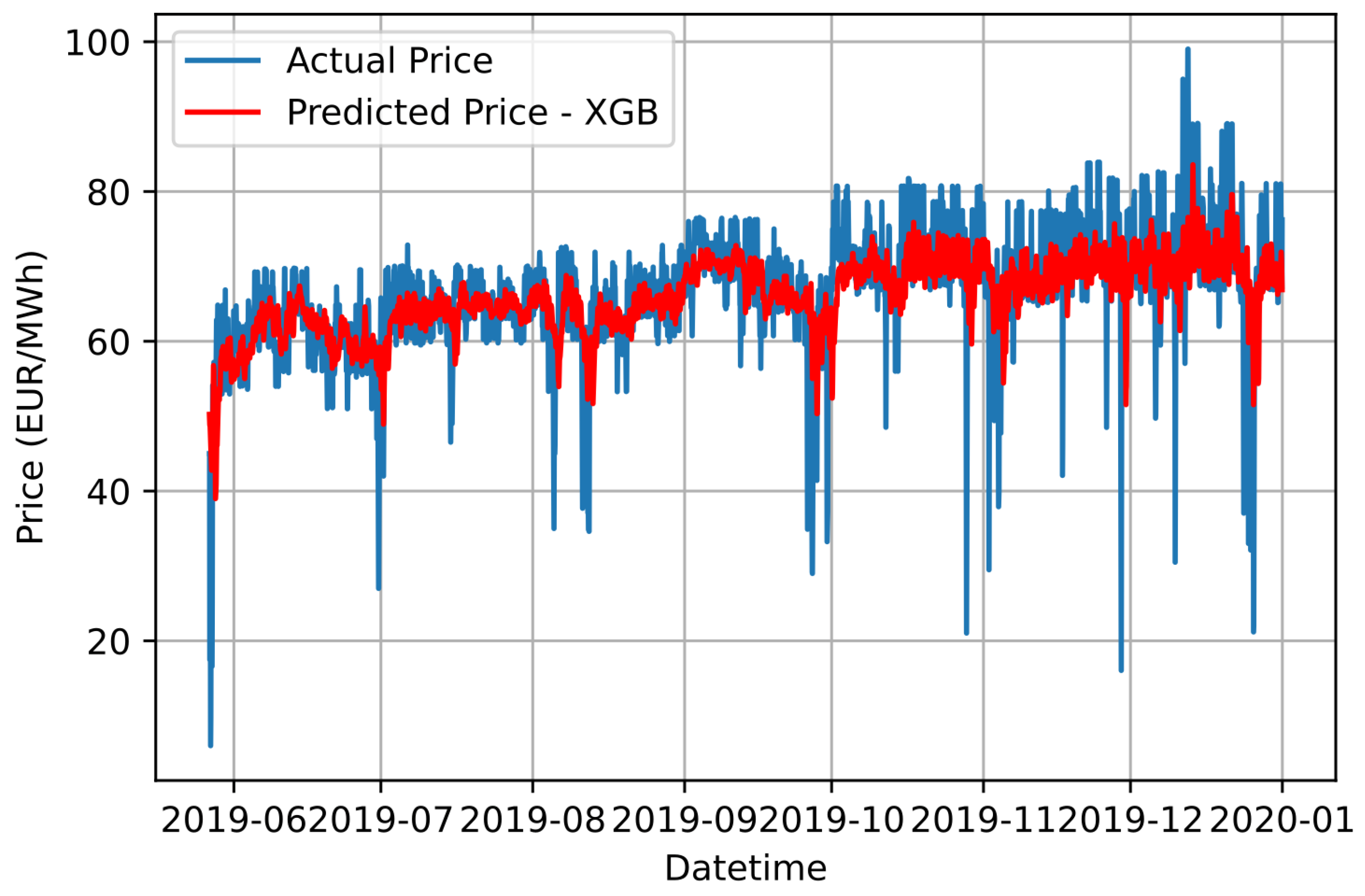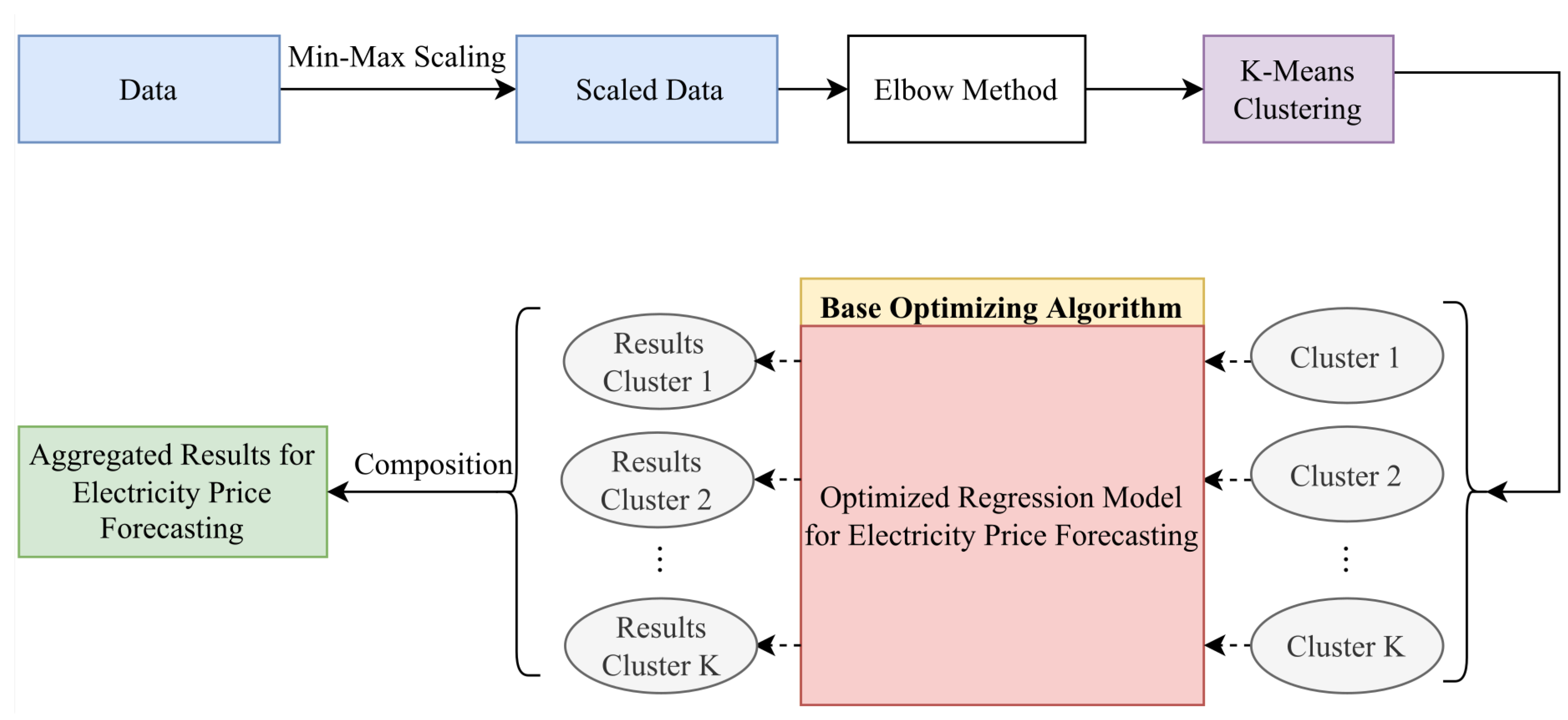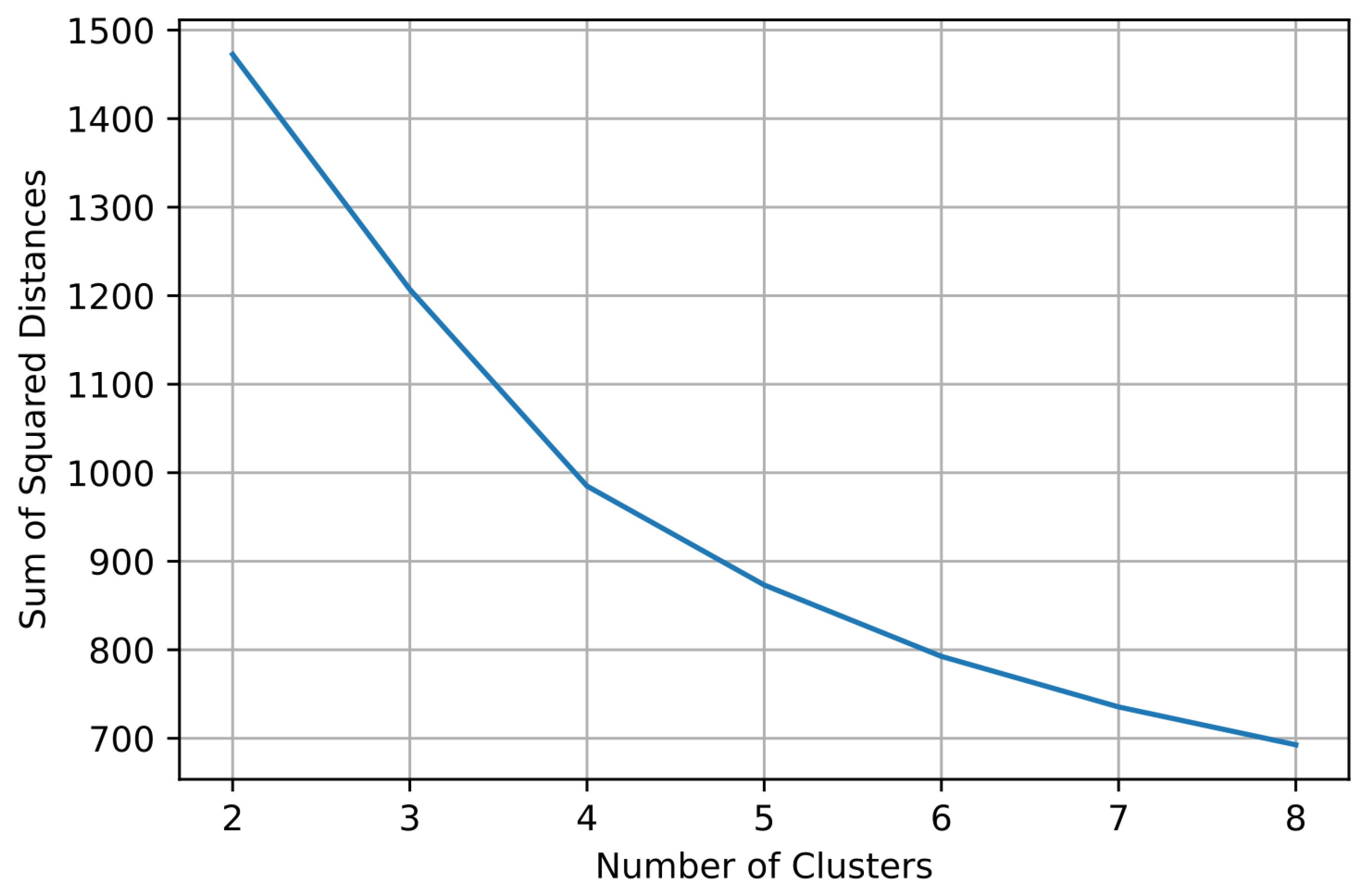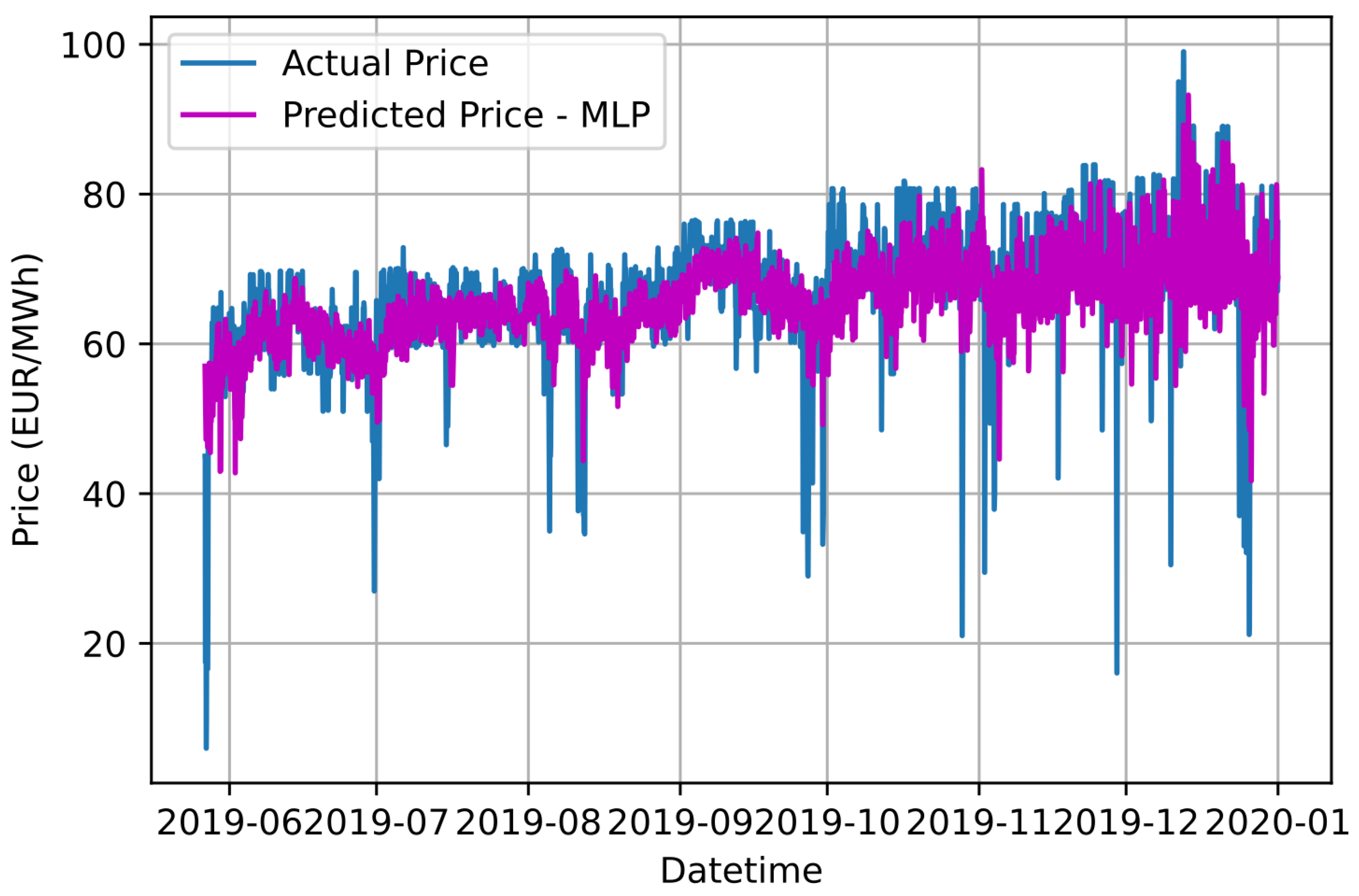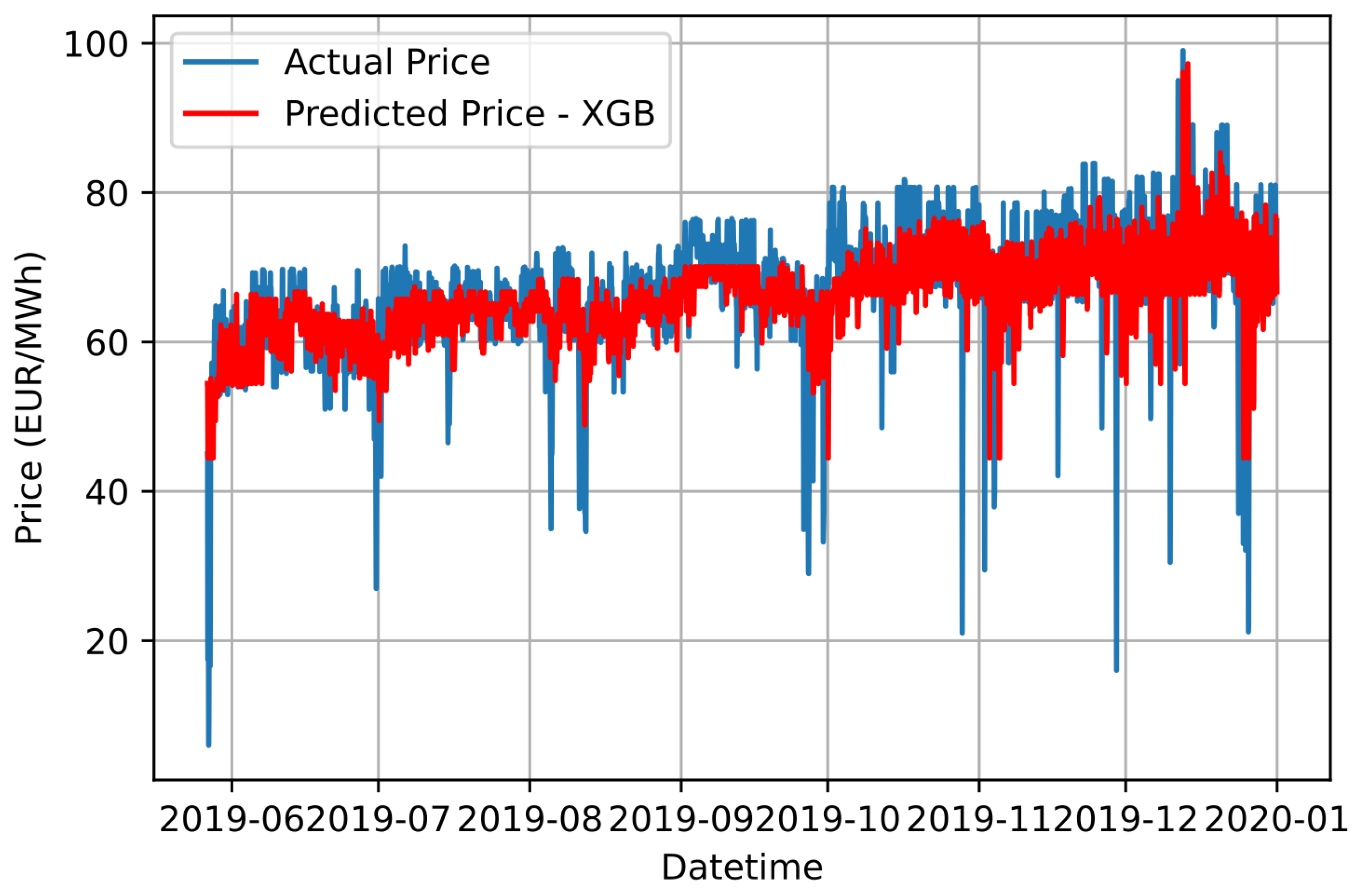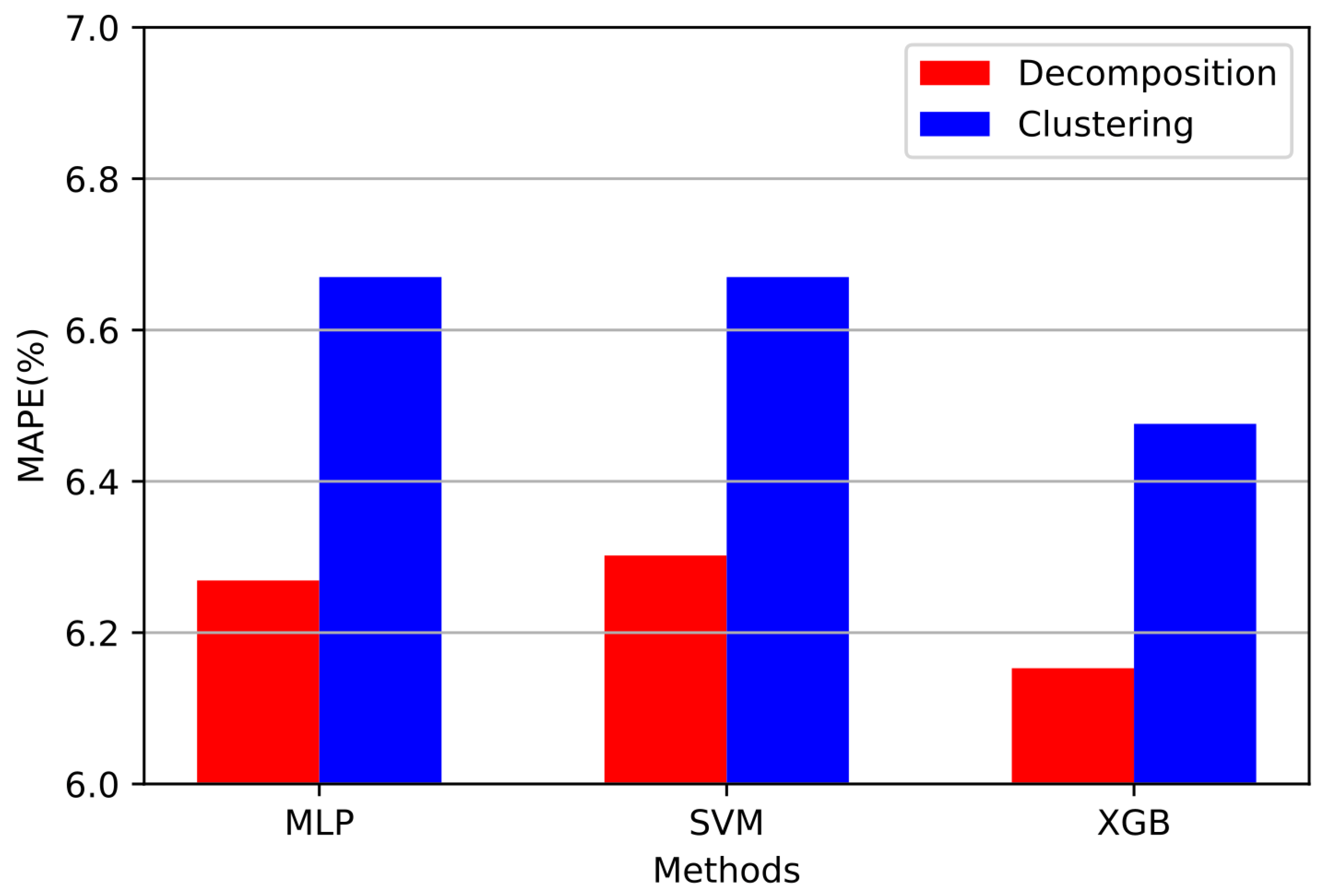1. Introduction
The landscape of the formerly monopolistic power systems has changed over the past few decades as a result of deregulation and the introduction of competitive markets [
1]. In many countries worldwide, electricity is traded through spot and derivative contracts in accordance with strict market principles [
2]. Electricity, on the other hand, is economically unstorable and contradicts the fundamental operating principle of power systems, which calls for a permanent equilibrium between production and consumption. With the advent of restructuring in the electric power industry, the price of electricity has become the focal point of all power market activity. The price of electricity is the most significant signal to all market players in a power market and the market-clearing price is the most fundamental pricing notion [
3]. Following the receipt of bids, the Independent System Operator (ISO) combines the supply bids into a supply curve and the demand bids into a demand curve. The market-clearing price is determined at the point where these two curves intersect and identifying it is essential for the efficient and orderly operation of power systems [
4].
Electricity price forecasting can be divided into three categories based on length of time: short-term, mid-term and long-term. In order to set up bilateral transactions or define bidding strategies on the spot market, this study primarily focuses on developing data-driven models for predicting short-term electricity prices. The spot electricity market usually conducts day-ahead auctions and does not support uninterrupted trade. Agents are required to submit their bids and offers for the delivery of electricity during each hour of the following day before a specific market closing time on the previous day.
In comparison to the load forecasting problem [
5], where the load curve is mostly homogenous and its variations are cyclic [
6], the electricity price forecasting problem has a non-homogeneous pricing curve and only weakly cyclic variations [
7]. At the same time, price spikes that occur when a system’s load level approaches its generating capacity limit have an explicit impact on prediction accuracy [
8,
9,
10]. Although the price of power is highly volatile [
11], it is not considered random. It is obvious that various physical factors could influence the electricity price, with some variables dominating over others. As a result, in short-term applications, it is critical to identify the parameters that have the most impact on price predictions. The time, i.e., the hour of the day, day of the week, etc., special days, previous pricing values and historical and predicted load values are the parameters that have the greatest influence on the outcome of electricity price forecasting.
Short-term electricity forecasting can be approached using two strategies, statistical methods [
12] and computational intelligence models [
13]. Statistical approaches forecast the current price by combining previous prices with prior or present values of exogenous factors. Simple Moving Average, Exponential Smoothing and Autoregressive Integration Moving Average (ARIMA) are some statical strategies that are successfully implemented in electricity price forecasting [
14,
15,
16]. Due to their flexibility and ability to manage complexity and non-linearity, computational intelligence approaches have been created to solve problems that traditional statical methods are inefficient at handling [
17]. Artificial Neural Networks (ANNs), Fuzzy Systems, Support Vector Machines (SVM), techniques for evolutionary computation and hybrid approaches that combine two or more computational intelligence algorithms have yielded satisfactory price prediction results.
The majority of recent papers in the literature that address the problem of predicting electricity prices usually propose a regressor model, an optimization method and an algorithm for signal decomposition of the price. Unlike the few regression models used to predict the price of electricity, the literature is replete with optimization strategies. Support Vector Regression (SVR) models, ANNs and Extreme Learning Machines (ELMs) are the major price forecasting models. Empirical Mode Decomposition (EMD), either as is or in some modified form, and Variational Mode Decomposition (VMD) are the primary techniques employed for signal decomposition. Those two approaches have found extensive application in the existing literature on price forecasting in general and their results have been thoroughly compared [
18].
In [
19], Ribeiro et al. use a combination of several non-linear models, including ELMs, Gradient Boosting Machine (GBM), SVR models and Gaussian Process (GP), to predict commercial and industrial electricity prices in Brazil for one to three months ahead. The suggested model is based on exogenous factors such as power supply, lagging pricing and electricity demand and the hyperparameters are chosen using the Complementary Ensemble Empirical Mode Decomposition (CEEMD) technique, the fine tuning of which is based on the implementation of the Coyote Optimization Algorithm (COA). Similarly, Qiu et al. [
20] used EMD to decompose the electricity price signal into numerous Intrinsic Mode Functions (IMFs) and a Kernel Ridge Regression (KRR) model to predict each IMF’s trends. The predictions of all IMFs were then utilized by an SVR to provide the aggregated price forecasting result for the Australian Energy Market Operator. Although this proposed method improved accuracy and efficiency compared to traditional methods, it failed to produce satisfactory mean absolute percentage error (MAPE) values. In another study [
21], Ensemble Empirical Mode Decomposition was used in conjunction with various regression models such as Recurrent Neural Network (RNN), Multi-Layer Perceptron (MLP), SVR and ELM to obtain the actual predicted price of electricity based on data from the power systems of New South Wales (NSW), Queensland (QLD) and Victoria (VIC). According to the findings of this study, computational intelligence models produce a large MAPE; however, the suggested ELM model paired with the Ensemble Empirical Mode Decomposition manages to reduce the MAPE to less than 10%.
Unlike EMD, VMD has not been widely adopted in the literature on electrical price forecasting, but it is found in applications for forecasting challenges such as carbon price prediction [
22], crude oil price forecasting [
23] and short-term wind power projection [
24]. In [
25], Yang et al. offer an adaptive hybrid forecasting model employing an Improved Multi-Objective Sine Cosine algorithm (IMOSCA) for the optimization of a Regularized Extreme Learning Machine (RELM), which is the first attempt to deal with EPF based on Variational Mode Decomposition. The MAPE values are close to 6% when using the proposed model. In a similar effort, Wang et al. [
26] used the Improved Variational Mode Decomposition (IVMD), as a data preprocessing technique, in order to decompose the original electricity price series into several modes. Then, they utilize the Chaotic Sine Cosine Algorithm (CSCA) enhanced with the Phase Space Reconstruction (PSR) in order to select the optimal input vector of each mode and use it for the prediction of the electricity price based on an Outlier-Robust Extreme Learning Machine (ORELM) model.
Similarly, clustering is another ensembled preprocessing method utilized to improve the outcomes of electricity price predictions. Although the theoretical foundations of these two preprocessing approaches differ, they both operate on the divide-and-conquer concept. A divide-and-conquer algorithm recursively divides a problem into two or more sub-problems of the same or related nature, until they are simple enough to resolve directly. The sub-problems’ answers are then merged to provide a solution to the initial problem. As a result, the signal decomposition method may be safely termed a clustering method.
An initial implementation of the clustering approach is conducted in [
27], where Ghayekhloo et al. present an enhanced data clustering technique for price-load input data in order to group them into an appropriate number of subsets utilizing six new game-theoretic methods. This unique cluster selection method based on the persistence approach is used to identify the best suitable cluster as the input to a Bayesian Recurrent Neural Network (BRNN) for electricity market day-ahead price forecasting. The proposed forecast model surpasses current state-of-the-art forecasting algorithms, demonstrating a significant improvement in prediction accuracy. In a different approach to data clustering, Pourhaji et al. [
28] investigate the seasonal data clustering effect on price forecasting. The energy price forecasting for the day-ahead horizon is based on data from Ontario province in Canada. The important parameters of the prediction are identified using the Gray Correlation Analysis (GCA) approach and the day-ahead electricity price forecasting is achieved using a Long Short-Term Memory (LSTM) model. Finally, the predictions are compared in three modes: non-clustering, seasonal clustering and monthly clustering. In an alternative study, Wang et al. [
29] propose a classification modeling strategy for predicting electricity prices based on daily pattern prediction (DPP). In this study, K-Means is used to cluster all of the historical daily electricity price curves and then the suggested DPP model is used to detect the following day’s pricing trend from the forecasting data supplied by numerous traditional forecasting methods. Then, for each individual daily pattern, a classification predicting model is developed and a credibility check on the DPP result determines which of them will be eventually employed. This approach is applied to real electricity price data from the PJM market, yielding more accurate forecasting results than the single integrated modeling approaches.
This paper examines the issue of short-term electricity price forecasting using historical price data from the Greek electricity market. More specifically, six robust prediction models that use subsets of the original dataset resulting from the application of VMD and the K-Means clustering algorithm are proposed. The regressor approaches used are an SVM, an MLP neural network and an XGBoost model, whose optimization is based on the Base Optimizing Algorithm (BOA). The forecasting results provided by each model are compared to each other, based on the MAPE, with the aim of choosing the forecasting model that provides the most accuracy. More specifically, by extensively studying the existing literature and identifying some gaps, the fundamental aspiration of this paper is:
To develop robust and optimized data-driven forecasting models in conjunction with the VMD or the K-Means algorithm that will improve the accuracy of electricity price predictions, compared to the existing results;
To propose an enhanced modification of the Particle Swarm Optimization (PSO) technique used for the selection of the discrete values of the VMD algorithms’ hyperparameters. The proposed algorithm is applied in identifying the local maximum (and not the local minimum as usual) of a well-defined objective function;
To propose the use of BOA as a front-end metaheuristic algorithm that will determine the appropriate values of the hyperparameters of each regression model;
To propose an XGBoost prediction model that will produce accurate results in a short convergence time;
To be the first paper that compares the effect of the signal decomposition and clustering approach on the results of electricity price forecasting.
This paper is organized as follows.
Section 2 analyzes the materials and methods used for the establishment of the proposed robust and optimized data-driven forecasting models. In
Section 3, the numerical results from the implementation of the proposed approaches in short-term electricity price forecasting based on historical data of the Greek electricity market are presented. In
Section 4, those results are analyzed and compared in order to determine the performance of the preprocessing techniques in terms of price prediction accuracy.
Section 5 summarizes and concludes the results of the proposed work and suggests topics for further research in the area of short-term electricity price forecasting.
2. Materials and Methods
In this section, the algorithmic structures of the signal decomposition methods, the K-Means clustering technique, the Base Optimizing Algorithm, as well as the various regression models used to design robust, highly accurate and data-driven forecasting approaches are presented and analyzed.
2.1. Signal Decomposition
Electricity price forecasting is mainly based on the signal that reflects the price of electricity to a currency (EUR/MWh or USD/MWh). This signal has certain oddities because it is influenced by many exogenous sources, yet it has a distinctive curve in the domain of time. Therefore, a variety of signal decomposition techniques can be used to better comprehend and monitor the signal relating to the price of electricity. According to the theory of decomposition, every signal is made up of various intrinsic oscillation modes. Each mode is an oscillation, or Intrinsic Mode Function (IMF), that is symmetric with respect to the local mean and has a maximum difference of one in the number of local extrema and zero-crossings.
A first approach to signal decomposition was presented by Huang et al. by establishing the Empirical Mode Decomposition (EMD) technique [
30]. EMD is an entirely data-driven strategy that decomposes a signal into several modes of unidentified but distinct spectral bands [
31]. One of EMD’s key advantages is that it automatically determines the ideal number of modes based on the signal’s characteristics. The derived modes are hierarchically arranged so that the first IMF has the highest-frequency component and the residual signal is left with the information of lower-frequency components [
32]. On the other hand, the algorithm’s robustness of decomposition is diminished by the absence of mathematical theory. Due to its recursive execution, EMD is noted for having restrictions including susceptibility to noise and sampling [
33] and does not support backward error correction. Additionally, it is prone to undermining the accurate identification of the extrema and as a result of that, of their upper and lower envelopes [
34]. This is due to the phenomenon of over-decomposition of a signal, which occurs when more IMFs are extracted than the number of oscillatory modes that comprise the original signal.
More robust variants, including Ensemble Empirical Mode Decomposition (EEMD) [
35] and Complete Ensemble Empirical Mode Decomposition with Adaptive Noise (CEEMDAN) [
36], have recently been proposed to solve the original EMD algorithm’s shortcomings in terms of sensitivity to noise and sampling. EEMD is a noise-assisted data analysis technique that may spontaneously divide the original signal into IMFs without the need of predetermined, subjective criteria. CEEMDAN is a variation of the EEMD algorithm, which offers a precise reconstruction of the original signal and improved IMF spectral separation. Even though it requires more computational power, this enhanced version, which uses White Gaussian Noise, is intended to significantly lessen the negative impacts of noise.
In a later attempt, Dragomiretskiy and Zosso [
37] proposed VMD, a more reliable and mathematically solid method. This method has been widely used in the diagnosis of gearbox faults [
38], the fault diagnosis scheme for rolling bearings [
39], the seismic time-frequency analysis [
40], the forecasting of crude oil prices [
41], the prediction of wind power [
42] and the forecasting of short-term load [
43]. In order to create a reliable, robust and accurate forecast model that might be employed in the EPF, this paper focuses on the application of VMD in the signal that reflects the hourly price of electricity. Therefore, the VMD algorithm’s structure as well as its benefits over competing decomposition techniques should be taken into account. The purpose of VMD is to decompose an input signal with real value into a discrete number of IMFs that are compact around a central pulsation, which is to be identified simultaneously with the decomposition. In particular, the squared norm of each IMF’s Hilbert supplemented analytic signal [
32] is used to determine each IMF’s bandwidth. Mixing each mode with a tuned exponential function causes the spectrum of each mode to be displaced on the approximated angular frequency. The demodulated signal’s Gaussian smoothness, which is the gradient’s squared Euclidean norm (L2-norm), is ultimately used to determine the bandwidth. The IMFs are updated using straightforward Wiener filtering in the Fourier domain to address the variational problem.
The VMD technique is resilient to noise and has been widely employed because it has been proven to be sensitive in identifying weak side-band signals that are frequently covered up by background noise [
44]. As a result, it has been asserted that the VMD technique is effective for signal denoising and detrended fluctuation analysis, with a temporal complexity order comparable to that of EMD [
45]. The decomposed modes are extracted continuously rather than iteratively grading enhanced error balancing, which makes EMD non-recursive [
46]. It has also been suggested in real-time pattern recognition implementations, demonstrating a significant improvement in efficiency over EMD and wavelet-based methods [
47].
The VMD algorithm is parameter sensitive, according to [
37], as the decomposition outcome mainly depends on the choice of penalty constant and decomposition number
K. Each IMF component has a constrained bandwidth under specifics
and
K. The requirement to predefine in how many modes (or clusters) data are to be binned is a common weakness of many segmentation methods. The parameter K in the VMD process determines how many modes the original signal is dived into. The selection of the penalty parameter
determines the IMFs’ bandwidth size. Therefore, the ideal pairing of parameters
K and
should be chosen in order to prevent overdecomposition/underdecomposition of the provided signal. These parameters are chosen either empirically, through a process of trial and error, or with an optimization algorithm. Particle Swarm Optimization (PSO) [
48], Cuckoo Search (CS) [
49], Gray Wolf Optimizer [
50] and the Chaotic Sine Cosine (CSC) method [
51] are a few optimization techniques that are utilized to configure VMD appropriately. Inverted and Discrete Particle Swarm Optimization (IDPSO), a novel and reliable methodology, is used in this study as the foundation for VMD parameterization. A mathematical and algorithmic analysis of IDPSO is provided in the following section.
Inverted and Discrete Particle Swarm Optimization into Variational Mode Decomposition
Particle Swarm Optimization (PSO) is a bio-inspired algorithm that has been widely employed in deep learning situations to optimize continuous nonlinear functions [
52]. This heuristic approach aims to locate the best solution in a high-dimensional space, or as close to it as is possible [
53,
54]. PSO differs from other optimization techniques since it does not depend on the gradient or any differential form of the objective function in order to arrive at a solution that is near the global minimum [
55]. Since the PSO is used to minimize an objective function for certain pairs of (
K,
) parameters in order to produce the best practicable parametrization, it may be simply adapted to the selection of these parameters in the VMD approach. The formulation of an objective function should be taken into account initially because the VMD technique does not include any mathematical functions that should be minimized. Due to this, different versions of multiple objective functions have been presented in the literature, including the ratio of 1 to kurtosis of decomposed signals [
56], the average of the envelope and Renyi entropy of modes [
57] and the ratio of the mean to variation of the cross-correlation signal between the original signal and the IMFs [
39]. In this paper, the objective function used is that of [
39] and therefore its mathematical function should be rendered.
Cross-correlation is a metric used in signal processing to determine how similar two signals are to each other. Correlation of two signals is defined as the convolution of one signal with the functionally inverse representation of the other signal. The cross-correlation of the two input signals is the name given to the resulting signal. The cross-correlation signal’s amplitude serves as an indicator of how closely the received signal resembles the target signal [
58]. The mathematical expression for the cross-correlation of continuous time signals
and
is given by Equation (
1):
Cross-correlation is used as a measure of the correlation between the initial signal and the decomposed modes as a result of the application of VMD for particular pairs
K and
in terms of the decomposition of the price signal. Cross-correlation, however, cannot be an objective function in itself; hence, it is important to use the information that indicates how much the cross-correlation signal varies from the mean value. The cross-correlation signal between the original signal and all IMFs’ mean values and their variance is therefore used to establish the proposed objective function. The objective function used in the proposed, enhanced version of PSO is given in Equation (
2):
Equation (
3) attributes the variance of the cross-correlation signal between the original signal and the decomposed modes:
where
N is the number of samples,
is the value of the signal at the
i-th sample and
is the mean of the signal. Therefore, the appropriate parameterization of the VMD is given for the constants
K and
in which greater correlation results between the original signal and all IMFs. Therefore, the pair (
K,
) that maximizes the objective function of Equation (
2) must be found.
Once the proper objective function has been established to be employed by the PSO in order to acquire the correct decomposition of the signal of the electricity price, the need for the application of an appropriate variation of this heuristic algorithm can be easily identified. The development of an inverted version of PSO is initially required, where it will search for the global maximum of the objective function rather than its global minimum. The implementation of PSO in discrete values of K and should also be considered for this specific differentiation, as demanded by the algorithmic analysis of VMD. This paper proposes the establishment of an Inverted and Discrete Particle Swarm Optimization (IDPSO) algorithm that will be applied as a front-end heuristic algorithm for the optimal parameterization of the VMD algorithm. The novel IDPSO-VMD algorithm is analyzed as follows:
Step 1: Initialize the values K and within the defined solution space. The pair (K, ) is a group of particles, the number of which is defined by the user, that is initialized with random values in order to find the global maximum of the objective function;
Step 2: For the initial particles of Step 1 the VMD algorithm is executed and the values of the objective function are calculated;
Step 3: The solution of the algorithm is considered to be the largest value of the objective function found in Step 2;
Step 4: The particles start moving towards the global best solution by updating the values
K and
. These variables should have integer values and for this reason they are updated based on Equations (
4)–(
7) as follows:
Step 5: For the new particles, the VMD algorithm is executed and the values of the objective function are calculated;
Step 6: In cases where the objective function displays a higher value of the existing global best solution for the new particles, the optimal solution is updated;
Step 7: Steps 4–6 are repeated until the parameters K and stop being updated, i.e., the particles stop moving towards the point that shows the optimal solution or the algorithm for the maximum number of repetitions set by the user is reached;
Step 8: The algorithm returns the best possible solution.
In Equations (
4) and (
6) the parameters
w,
and
are user-defined constants that represent the inertia of the particles and how sensitive they are to the current best and the global best solution, respectively. The variables denoted as
and
are random numbers between 0 and 1. Therefore, the results of Equations (
4) and (
6) become a distinct value when applying a well-defined Python function, which returns the closest to the resultant integer number.
2.2. Data Clustering
Unsupervised learning techniques like clustering are frequently used to discover significant structure, explanatory underlying processes and generative features in a large dataset. The fundamental concept behind clustering is that homogeneous data groups are produced by splitting a given set of data points into a set of groups that are as identical as possible. It is crucial because it establishes the inherent grouping among the existing unlabeled data. Because the efficiency of clustering is directly affected by the type of data, it is not surprising that a variety of methodologies, including probabilistic, distance-based, spectral and density-based strategies, are utilized in the clustering process. Each of these techniques has advantages and limitations of its own and may be effective in various situations and different domains.
Clustering analysis is widely utilized in a variety of fields, including market research, pattern recognition, image processing and the analysis of biological data. In recent years, the necessity to upgrade traditional power systems and convert them to Smart Grids has expanded the number of installed smart meters, which has increased the amount of electrical network data that is currently available. Therefore, clustering finds wide application in datasets that consist of time-series concerning both load forecasting and electricity price forecasting. It should be highlighted that identifying data that are developing over time differs significantly from classifying data that are static. Due to the significant differences in the behavior of the data variables across different parts of the datasets, high dimensional datasets, such as those referring to short-term electricity price forecasting, provide unique difficulties for cluster analysis.
Time series clustering frequently involves the use of conventional cluster analysis techniques including hierarchical and non-hierarchical clustering approaches. In this first case, an appropriate distance measure for comparing time series is established, inheriting the dynamic aspects of the time series and then a typical hierarchical cluster analysis is used while utilizing the provided distance measure. In the latter case, partitioning clustering approaches divide a set of data points into
K clusters. This procedure typically follows the optimization of a criterion function that represents the inner variability of the clusters during the minimization of an objective function. One of the most well-known and often used non-hierarchical clustering algorithms is K-Means clustering, which aims to partition the data in an effective manner by minimizing the Sum of Squared Errors (SSE) criterion through an iterative optimization process. Denoting as
the
k-th cluster,
a point in
,
is the mean (centroid) of the
k-th cluster and
K the number of clusters, the SSE is given by Equation (
8):
K-Means starts by choosing K representative points as the initial centroids. Next, based typically on Euclidian distance, each point is allocated to the nearest centroid. The centroids for each cluster are updated after the clusters have formed. Afterwards, the algorithm iteratively repeats these two steps until the centroids remain the same or a different relaxed convergence condition is satisfied. The initial centroids and the estimated K-Means optimal number of clusters are the two main variables that can affect the performance of the method. The most important aspects influencing the efficiency of the K-Means algorithm are the initial centroids and estimating the ideal number of clusters K.
The initial centroids in this study are chosen using the K-Means++ approach. This algorithm employs a straightforward probability-based approach in which the first centroid is chosen at random. The next centroid determined is the one that is farthest away from the present centroid. This decision is based on a weighted probability score. The selection process is repeated for K iterations. The Elbow Method is used to solve the problem of estimating the ideal number of clusters K.
Determining the Optimal Number of Clusters—Elbow Method
A major challenge in partitioning clustering is determining the optimal number of clusters in a dataset, which involves the user defining the number of clusters K to be formed. The appropriate number of clusters is rather subjective and depends on the method used to measure similarities as well as the clustering algorithm’s parameters. As previously stated, the purpose of the K-Means clustering algorithm is to segment data effectively while minimizing SSE. However, its rate of decrease varies depending on whether it is above or below the optimal number of clusters K. The inertia reduces rapidly for , whereas it decreases slowly for . The user can therefore identify the point where the curve bends or elbows and determine this point as the ideal number of clusters by visualizing the inertia across a range of k. However, because various users may locate the elbow in a different spot, this method is somewhat arbitrary.
In our work, the clustering algorithm under consideration is K-Means and its implementation is based on Python’s library scikit-learn [
59]. The clustering approach is implemented on historical data of electricity price and hourly weather data such as temperature and humidity. The ideal number of clusters is determined using the Elbow Method. Therefore, for a range of clusters, the SSE resulting from the use of the K-Means algorithm is calculated and graphed.
2.3. Regression Models
In this paper, the use of an SVR, an MLP neural network as well as the innovative and highly efficient XGBoost model is proposed to address the electricity price forecasting issue. The SVR and the MLP neural network were built based on the scikit-learn library [
59], and the XGBoost model with the corresponding Python library.
2.3.1. Support Vector Machines
Support Vector Machine is an algorithmic approach appropriate for supervised learning, the primary intention of which is to find a hyperplane in an
N-dimensional space (where
N is the number of features) that distinctly allocates the data points [
60]. There is a variety of different hyperplanes that might be used to split the subclasses of data points. The primary goal of using SVMs to address a classification problem is to determine a hyperplane that has the maximum margin, or the maximum distance between data points from the distinct classes. When applied to a regression problem, they aim to predict a real function (
f) using pairs of input—output training data produced similarly and independently dispersed in accordance with an unknown probability distribution function. Since Support Vector Regression (SVR) is one of the regression models employed in the problem of short-term electricity price forecasting, its method will be investigated in this study.
Margin is a classification-specific concept. The purpose of SVR is to establish a function that has the least amount of deviation (
) from the real targets for all of the training data while also being as flat as possible in order to avoid using overcomplicated regression functions. Thus, results with inaccuracy less than
are accepted, but deviations greater than
are unacceptable [
61]. Using the
-sensitive loss function of Equation (
9), an equivalent of the margin is built in the space of the target values
y:
A regression function that generalizes efficiently is determined by modifying both the regression ability via the weight vector
w and the loss function. The data are fitted to a tube with a radius
. The trade-off between the complexity term and the empirical error is adjusted by the regularization constant
C, which accepts values greater than zero [
61]. The objective function of Equation (
10) that should be minimized, known as
C-SVR, is as follows:
SVRs are extensively used in short-term electricity price forecasting applications because of their many advantages, the most important of which are encapsulated in their robustness to outliers, their ease of implementation, which reduces their computational complexity and their ability to use a symmetrical loss function, which equally penalizes high and low misestimates [
62]. Therefore, SVRs should be optimized by selecting the proper hyperparameters in order to be implemented effectively. The parameters that should be optimized using the BOA metaheuristic algorithm are the kernel type, the strictly positive regularization parameter
C and the radius
of the epsilon tube-SVR model [
63].
2.3.2. Extreme Gradient Boosting
A gradient boosting framework is used by the decision-tree-based ensemble machine learning method known as Extreme Gradient Boosting (XGBoost) [
64]. Boosting is an ensemble strategy in which new models are sequentially introduced to rectify errors committed by previous models until no more improvements are possible [
65]. Gradient boosting is a method where new models are made to forecast the errors or residuals of earlier models, which are then combined together to provide the final prediction. Because it employs a gradient descent approach to reduce loss when introducing new models, it is known as gradient boosting [
66]. The mathematical aspect of the XGBoost algorithm, which explains how boosting is accomplished, and the algorithm’s greedy behavior are fully discussed in [
64].
XGBoost is a novel sparsity-aware parallel tree learning algorithm built on a highly scalable end-to-end tree boosting framework. This algorithm has piqued the scientific community’s interest because it focuses on computational speed and model performance. It is a perfect combination of software and hardware optimization techniques as it produces superior results with fewer computing resources in the shortest amount of time.
To properly leverage the benefits of the XGBoost method in our work, the model needs to be fine tuned with the suitable selection of specific hyperparameters. As previously stated, the BOA method is used to determine the learning rate, i.e., a step size shrinkage used to prevent overfitting, the
parameter, which is a minimum loss reduction required to make a further partition on a tree’s leaf node, the maximum depth of a tree and the
regularization term on weights defined as
[
64].
2.3.3. Multi-Layer Perceptrons
One of the most significant and often used types of neural networks is the Multi-Layer Perceptrons (MLPs). They are highly interconnected, nonlinear systems which can be used for both nonlinear classification and nonlinear function approximation applications [
67]. Due to their straightforward architecture, which is entirely defined by an input layer, one or more hidden layers and an output layer, they have found use in a number of power system engineering challenges, including the forecasting of short-term loads and electricity prices.
MLPs are global approximators that may be trained to implement any specified nonlinear input–output mapping given a set of features (
X) and a target (
Y). Each neuron in the hidden layer adjusts the information from the preceding layer using a weighted linear summation followed by a non-linear activation function (
G). The values from the last hidden layer are sent to the output layer, where they are converted into output values. The value that each neuron takes in the hidden layer is calculated by Equation (
11):
Multi-Layer Perceptron (MLP) continuously updates initial random weights to minimize a loss function, often the Mean Square Error loss function. A backward pass propagates the loss from the output layer to the preceding layers after it has been computed, giving each weight parameter an update value intended to reduce the loss. The Mean Square Error loss function is provided by Equation (
12), where
denotes the real values and
denotes an
-regularization term that penalizes complex models, where
a is a non-negative hyperparameter that regulates the severity of the penalty:
MLPs demonstrate their interpolation capability in a subsequent testing step by generalizing even in sparse data space areas. Performance and computational complexity factors are important when constructing a neural network, especially when using a fixed architecture [
68]. It has been demonstrated mathematically that even a single hidden-layer MLP may approximate the mapping of any continuous function [
69]. In this paper, the MLP consists of a hidden layer and it is trained via the backpropagation algorithm. In order to create an optimized model that will bring high accuracy to the prediction result, the BOA metaheuristic algorithm is called upon to determine the appropriate values of the hyperparameters of the MLP. In our work, these hyperparameters are the number of neurons in the hidden layer of the MLP and the number of iterations (epochs) used by each data point during the training of the neural network.
2.4. Base Optimizing Algorithm
In mathematics, the study of problems involving the minimization or maximization of a real function by methodically selecting the values of real or integer variables within a permitted set is referred to as optimization. Concurrently, there are plenty of optimization issues in many research areas, particularly engineering. A generic algorithm framework, based on approximation techniques, is used to address these optimization issues. It mainly contains metaheuristic algorithms that can locate a workable solution in an acceptable amount of time. Fred Glover was the first to introduce the word “metaheuristic” to refer to an algorithmic structure that often applies to a wide range of optimization problems with only a few adjustments to conform to the particular problem [
70]. The main strengths of metaheuristic techniques are their inability to be restricted to a specific problem, their ease of extension from basic local search to sophisticated learning techniques and their capability to explore the search space for a suitable solution while avoiding premature convergence. Metaheuristics’ principal objectives are exploration and exploitation and a successful trade-off between the two is essential to an effective search process [
71].
The Base Optimization Algorithm (BOA) is a mathematical, population-based metaheuristic algorithm proposed by Salem [
72]. This approach uses a combination of basic arithmetic operators along with a displacement parameter (delta) to efficiently guide and redirect the solutions towards the optimum point. In the first step, an initial population of solutions is produced at random. The displacement parameter and the number of solutions that constitute the initial population (number of particles) are defined. Then, each initial solution is evaluated and for each one, a vector with four possible solutions that are calculated using the Equations (
13)–(
16) is created, within a predefined range:
Each potential solution is evaluated according to how efficiently it minimizes (or maximizes) the predefined objective function. After being assessed, the best of the four potential solutions is then picked as the new candidate solutions (next solutions). When the number of executions approaches the predetermined maximum number of iterations or when another user-defined convergence criterion is satisfied, the algorithm ends. The algorithmic architecture of the BOA is shown in the flowchart in
Figure 1.
In this paper, BOA is used for the fine tuning of three different regression models used for short-term electricity price forecasting. More specifically, this metaheuristic algorithm is used to determine the appropriate values of the hyperparameters of an XGBoost model, an SVM and an MLP neural network that are used for prediction. The step of these models’ fine tuning, through the BOA, is particularly crucial as it aims to establish data driven models that will significantly enhance the prediction outcome of short-term electricity price forecasting.
